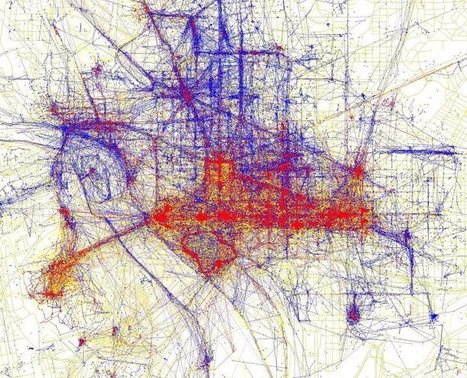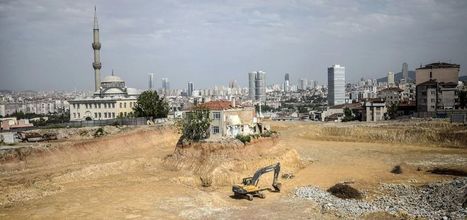Get Started for FREE
Sign up with Facebook Sign up with X
I don't have a Facebook or a X account
 Your new post is loading... Your new post is loading...
 Your new post is loading... Your new post is loading...

Mr Mac's curator insight,
July 6, 2017 8:16 AM
Unit 7 - Gentrifications - specifically addressing "generalizations about Gentrification."

Deanna Wiist's curator insight,
September 12, 2017 9:01 PM
This post will need many disclaimers, but I think that it is a valuable addition to our gentrification materials since the key take-home point is that gentrification doesn’t happen the same way in all places (geographic context matters!). Some of the generalizations about gentrification around the country might not apply to some specific examples. Are these generalizations true in some (and possibly most) contexts? Sure, but unfortunately once people hear the word gentrification, they assume a base set of assumptions about the situation which may or may not be true. The 5 myths outlined in this video (more detail in this Washington Post article) are:
Tags: neighborhood, gentrification, urban, place, culture, economic.

asli telli's curator insight,
October 15, 2015 1:37 AM
What is "typically" #Dutch? #sea #saltwater #sailing #trade #ancient #heritage

Marc Meynardi's curator insight,
June 2, 2015 1:53 AM
This tradition is particularly appreciated by Chinese tourist. Annecy got a bride called "lLe Pont des Amours" where love locks are regularly removed. 
Leslie G Perry's curator insight,
June 2, 2015 8:32 AM
I LOVE Seth Dixon's insight on this and how it figures in with Design Technology. What mark do we leave and why? What are the unintended consequences of leaving out mark? Seth Dixon's insight: Graffiti, tombstones, love locks, monuments...each of these are manifestations of people's desire to have some tangible impact on the landscape. Something that manifests a connection to place in a profoundly personal way.
Questions to Ponder: Why do people want leave a mark on places that are meaningful to them? When do you think that they that these markers are appropriate or inappropriate? Do we have more of a 'right' to mark some places than others? Why do many oppose these personal marks on the landscape?
Evan Margiotta's curator insight,
March 19, 2015 4:18 PM
Gentrification is an interesting concept. Here in Austin we are seeing these signs all over the city. In a growing cities with growing economies the outskirts of the cities are being built up and expanding to allow for their growth. Gentrification is a very common event today, especially in places like Austin with thriving economies. However it often displaces a lot of the population with roots in that area. Its often considered a controversial topic, but is rarely talked about because of it complexity and the fact that it is often viewed as a very good thing. Unit 2 Population
Emily Bian's curator insight,
March 22, 2015 8:48 PM
7) Uneven development, zones of abandonment, disamenity, and gentrification This article was written by a woman who noticed a lot of changes in Washington D.C. Gentrification led to these many changes, by becoming not as unique and urbanizing at other people's expense. She describes gentrification as remodeling very quickly and ferociously. A lot of the things she says are for the general good of the people, like installing street lights, but don't take into consideration the people who don't appreciate the changes. Stores like walmart are taking over the family owned stores, and more people are moving in. This article describes gentrification perfectly, and I like her pictures to go along with it. I think this would help introduce this vocab term to new students. 
Lydia Tsao's curator insight,
March 24, 2015 12:29 AM
Sadly, gentrification happens all across the world. Poor populations in cities are disadvantaged and often have to move out due to wealthier populations moving in. One of the signs I found most disturbing was that police will start patrolling the areas where wealthier and poorer populations mix. This is a sad reality. Police do this to ensure that crime rates are low as poor people would be more tempted to commit crimes in wealthier neighborhoods. I do think this police patrolling has racist roots since the poorer population in Washington D.C. is mostly black. Words like "renewal" and "redevelopment" hide the sad reality behind gentrification/
Amber Coleman's curator insight,
May 11, 2017 10:59 AM
This article relates to my class because we have just discussed the idea of gentrification. I understood that gentrification was the immigration of richer people to poorer areas, but I didn't realize that it was to the point that people would completely loose their homes. However, I know that it is happening because of urbanization.
Lucas Olive's curator insight,
May 11, 2017 2:38 PM
This article relates to what we have been learning in class because this article explains what gentrification is, which is a big part of urbanization. My opinion on gentrification is that it is not good for most people in the area that is being gentrified, it's only good for a few people, usually they're rich.
Kassie Geiger's curator insight,
May 12, 2017 11:50 PM
Gentrification is the process of converting an urban neighborhood from a predominantly low-income, renter-occupied area to a predominantly middle-class, owner-occupied area. To be completely honest I can see how gentrification can be a good thing and a bad thing. The bad part about it is that people could be possibly moving out of a childhood home or a home with sentimental value. While on the other hand it could be a good thing by building new more modern housing that could check the boxes of people "needs" when they are looking to buy a house, especially first-time buyers. They may want a house with a up-to-date kitchen, 4 or 5 bedrooms, an up-to-date bath or two. I can totally understand that to get things how you want them to be in an older house can be extremely difficult and costly. However, some people may want an older house to pass onto their children, to grow old in.
That's pretty much all I have to say about gentrification without going completely off topic.

Ms. Harrington's curator insight,
April 12, 2014 7:28 AM
What a decade can do to a cultural landscape.
Jake Reardon's curator insight,
April 21, 2014 5:49 PM
To be honest I am surprised that "Mom and Pop" storefronts lasted this long in New York City. It just seems to me that as a city grows and rent prices go up the smaller store fronts would naturally be pushed out by larger conglomerates who would be more suited to handle the rent prices. Of course it is an old addeage of capitalism that as long as you offer a good product that consumers would be inclined to consume you can stay above water in even the most competitive locations. Although to me that would appear to have its limits. Perhaps the economic tides of the present in New York are that limit. |
Hailey Austin's curator insight,
May 11, 2017 2:34 PM
This is related to what I'm learning in class because its talking about urbanization. It talks about how a man visits a very run down place and invest in fixing it up a bit. He rebuilt a house/building. It made the city look better. My opinion on the article is that its a very good deed. Bringing a city back to life is a wonderful thing.
Harley Bass's curator insight,
May 11, 2017 2:35 PM
This connects to are lesson on chapter thirteen through gentrification. My opinion on this video is that gentrification in this neighborhood is good because it is bringing life back to its local community. Gentrification can be a bad thing in some neighborhoods though because it can force poor families out of their home.
kyleigh hall's curator insight,
May 12, 2017 11:21 PM
This article is about a person who bought a house in the suburb areas of New York. He put certain things in his house that is all historically or better for the world. This relates to what we are learning in world cultural geography because we are learning about the suburbs area and inner city areas of places. In my opinion it related to what we learned about a lot also I liked what he did with the stuff he used.

asli telli's curator insight,
August 15, 2015 1:34 AM
Also applies to unfortunate Turkey w/her recent urban transformation wave...
Shane C Cook's curator insight,
May 27, 2015 5:57 AM
Another testament to why gentrification is effective yet harmful to the political status of a country or area, not producing accurate results to fit the people's needs.
Timothée Mariau's curator insight,
December 13, 2015 12:28 PM
Cet article parle de la gentrification dans le quartier d'Highland Park à Los Angeles. Ce quartier est un quartier avec une population majoritairement hispanique est constitué durant les dernières années une enclave résidentielle pour les habitants. Ce quartier était un symbole de la ségrégation raciale que connaissent une partie des villes américaines avec une concentration d'une seule population d'une seule origine ethnique dans le même quartier sans mixité sociale. Mais ces dernières années le quartier a été touché par un processus de gentrification qui a été plutôt bien accepté par les populations du quartier car cela a apporté de la mixité sociale dans le quartier avec l'arrivée de populations plus aisées provenant de différentes communautés et qui ont également créé des commerces dans le quartier. Cette gentrification qui est la plupart du temps vue d'un mauvais œil par les anciens résidents du quartier est ici acceptée car elle bénéficie en partie à la population du quartier, de plus la communauté hispanique est très importante culturellement et le fait savoir. Il y a donc une intégration des nouveaux arrivants mais en gardant tout de même l'identité originelle du quartier qui est très forte.
Andrea J Galan's curator insight,
February 23, 2016 12:24 PM
Andrea's Inshight: I feel like the author is trying to make himself sound a little bit above the "barrio" when he says "multiethnic mount Washington". And then continues by sarcastically mentioning the charms and dysfunctions of the neighborhood. At first I was put off because I've never viewed HLP as a barrio. When I see that word I think of a ghetto slum. Which I don't think my nieghboorhood ever is. I've always viewed it as a working class neighborhood. I just dont like the barrio I think it puts a negative connotation towards the neighborhood.
Kendra King's curator insight,
April 3, 2015 7:39 PM
Normally I am annoyed at projects that end up destroying history, but in this instance I think the area needs to be remodeled. Part of the reason I am not fazed by the history being lost is because a fair amount of the area was already so poorly kept that many of the structures were either ruble or dilapidated. At the rate the area was going, it was already going to lose its history anyways. While it would be nice of the government to keep a small portion of the good standing landscape, I think the museum being built in the area is a nod at maintaining there history. So since you can’t have it all, I would rather side with the government trying to raise the standard of living for people who have been in continuous abject poverty since about the 13th century. As you said before, invest something in an area and you typically get something in return. Plus it seems that most of the people angered by this move are those outside of the area being remodeled (i.e. historians). I personally think those people are farther removed from the actual decision then those living there. So once again, I am happy to side with the people being most affected by the poverty stricken land.
Felix Ramos Jr.'s curator insight,
May 6, 2015 10:27 AM
As a man who graduated with a Bachelor's degree in History, it goes without saying that this causes me sadness. But even taking the history component out of the picture, this reformation project is also destroying much of that area's culture and identity. They are risking the few details that remain of their culture's past in order to move the area onto a more global scale. Another negative is the fact that they are picking up the poverty-stricken residents of this community and shipping them to another part of town like they are pieces of livestock.

Bob Beaven's curator insight,
March 19, 2015 12:46 PM
Most people often forget that the Silk Road passed into Central Asia and the Middle East from East Asia. This means that along the road, travelers often put things that reminded them of home. The Buddha statues that once existed in Afghanistan are an example of this. They were in fact labeled a world heritage site. Sadly, the Buddhas had been ravaged throughout history by radical arabs. This is because their religion frowns upon (actually forbids) idols, which they considered the statues to be. Although they had been tempered with for many years, the Taliban finally decided to blow them up in 2001. Now, there are differing opinions across various countries as to whether they should be rebuild or not. Afghanistan believes that they should be rebuilt so the government can claim a symbolic victory over the Taliban. Unesco wants a restoration done right, so for now it won't allow rebuilding to occur. Germans tried to rebuild them, but Unesco blocked it from happening. South Korea, Italy and Japan are all willing to donate money, but have no mention of the statues. I believe that the statues should be rebuilt, as the article points out monuments were rebuilt in France after Protestants burnt down many old Gothic Cathedrals. I also believe it is necessary because we cannot let the culture of hate that the Taliban believes in to win. Average Muslims realize that the statues have historical significance and that they do not need to worship Buddha to respect that this site was 1,500 years old. I also think it would send a strong message from the Afghan government if the statues were rebuilt because it would show they, like the article states, are not going to let the Taliban rule their country.

Kristin Mandsager San Bento's curator insight,
April 7, 2015 9:42 PM
I find it interesting that other countries are divided. Why are they deciding the future for this country? They can't seem to get out of their ways to come up with a real solution. Its unfortunate.
Benjamin Jackson's curator insight,
December 14, 2015 11:40 AM
this is a reminder of what extremism can do to ancient works of art that they view as heretical. these ancient, massive statues were carved out of living rock by ancient Buddhists, and had withstood the test of time until Afghan terrorists blew them up. |



























